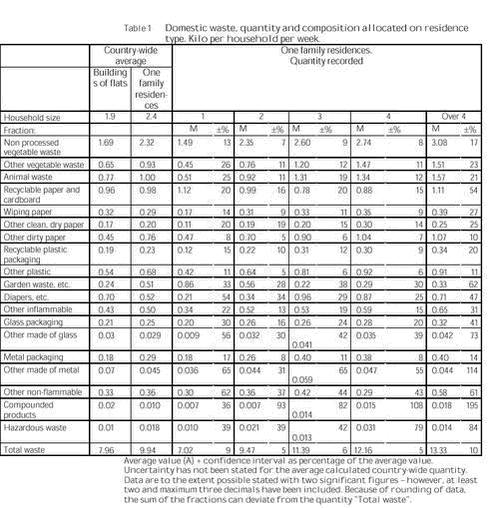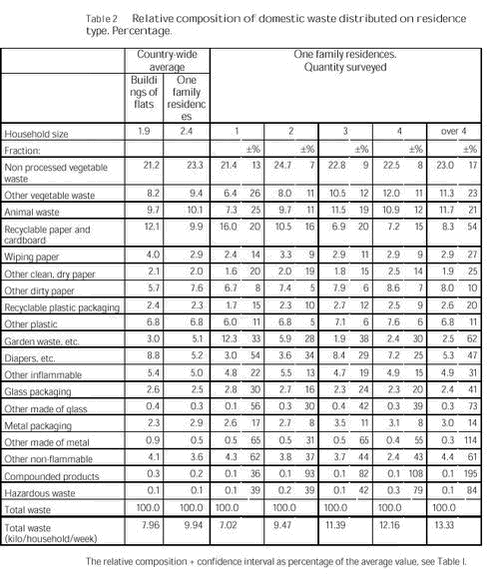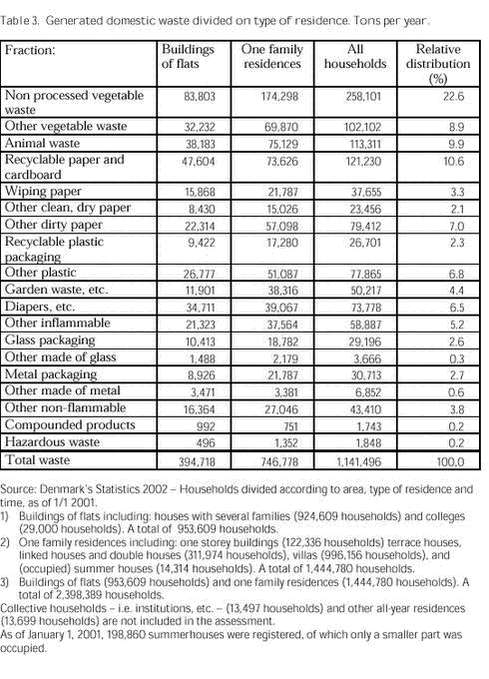Sammensætning af dagrenovation og ordninger for hjemmekomposteringSummary and conclusionsThis report presents a survey of the quantity and composition of domestic waste. Furthermore, an evaluation has been made of methods for home composting of the organic part of the waste. Waste analyses of the domestic waste from almost 2,200 households are included in the report. Parallel with the survey, a questionnaire survey was carried out among the same households. The population of the report 10 random checks have been selected, including a total of 1.607 households in one family residences and 603 households in buildings of flats. The random checks have been selected in areas spread out in the entire country. Each random check reflects the composition of residence types in the area in question, while the composition of a random check has been chosen so that to the largest extent possible it corresponds to the distribution of household size and residence type on a country-wide level. The procedure for selection of random checks considers first and foremost the criteria applying to data for the waste analyses. Secondly, efforts have been made to secure a broader coverage of methods for home composting. Among the 1,607 one family residences, 1,421 identifiable waste bags have been collected. 1,321 of these are included in the final report. Waste analyses One week’s domestic waste has been selected from each household. The waste from the individual household has been manually sorted in 19 fractions, which have all been weighed and registered. The quantity that is registered corresponds to the composition of waste after one week’s storage time. While the waste is stored, some fractions will absorb moisture from others. In the analysis, account is taken of this wandering of moisture. Uncertainty The uncertainty of determining the waste quantity for the respective fractions has been calculated. The uncertainty varies for the different fractions. This is due to the following:
If the results of the report are used to determine the generation of waste in a given area, one should be aware that deviations could occur in relation to the mentioned average values. The quantity and composition of domestic waste Residence type and household size are important parameters when describing the quantity and composition of domestic waste. Among one family residences, the quantity and composition of the 19 fractions have been determined for each household size. In buildings of flats, several households use common collection equipment, and the composition of the waste can therefore not be assessed in terms of size of household. The quantity of waste assessed for buildings of flats and one family residences respectively is shown in Table 1. For one family residences the distribution on household size is also recorded. The relative composition of the waste is stated in Table 2. Among one family residences, the quantity of the 19 fractions increases generally with the size of the household. However, two factions differ in this respect. The quantity of garden waste in the domestic waste decreases significantly with the growing size of the household. This can be explained with the fact that smaller households have a remaining volume at their disposal in the waste bag. The quantity of recyclable paper and cardboard is by and large independent of the household size. Comparison with other surveys indicates that the quantity of newspapers/weekly magazines and advertisements/printed matter decreases with growing household size, whereas the quantity of recyclable paper and cardboard increases with household size. Apparently the smaller households more often use the waste bag to get rid of newspapers/weekly magazines and advertisements/printed matter than the larger households. This can be due to the fact that the smaller households have a remaining volume at their disposal. From buildings of flats an average of close to 8 kilo domestic waste is collected per week. The composition is determined for an average household size of 1.9 individual. Households in buildings of flats generate on average less domestic waste than households in one family residences. On the basis of the results of the report, the total generated domestic waste in Denmark is calculated to be 1.14 million tons per year – see Table 3. The calculated quantity is merely that part of the domestic waste which is being disposed of through the households’ waste bag/- container. Consequently, the calculated quantity does not cover the waste that is being collected as waste similar to domestic waste from industry or glass and paper collected using other methods. Since 1979 where the first Danish survey of domestic waste was carried out, the quantity of domestic waste per household from one family residences has been reduced from 11.8 kilos (1979) to 9.9 kilos (2001). The largest reduction has occurred for the paper fraction and for glass packaging. During the same period the quantity of diapers has on the other hand increased. The relative distribution of the composition of the domestic waste has consequently also changed from 1979 until 2001. The share of food waste has increased, while the share of paper and the share of miscellaneous other than inflammable (glass) has decreased. An increase has taken place from 1993 until 2001 in the share of food waste, while the share of paper has decreased. Assessment of methods for home composting Methods for home composting have been assessed on the basis of a questionnaire survey among the same households that were included in the waste analysis. The answers given by the individual households about the handling of the organic waste have been compared to the actual contents of the waste bag. On the basis of this it has been possible to calculate the share of the organic waste that is actually being composted in their own garden. The survey shows that a household that participates in a system for home composting composts an average of 45 – 55 kilo vegetable waste per household per year. It appears that a household on average only home composts a third of the quantity of vegetable food waste compared to what was assumed in previous surveys. It has been calculated that the households that allegedly compost the most, compost a maximum quantity of 1.5-1.8 kilo per week or 78-94 kilo per year. This quantity is only achieved by the households who inform that they compost all (100 percent) of their fruit and vegetable remains. The questionnaire survey shows that even among the households who indicate that they compost all fruit and vegetable remains, approx. 1 kilo non-processed vegetable waste is still found every week in the waste bag. Another result is that only among the households who indicated in the questionnaire that they compost almost all their vegetable food waste, a significant reduction of this type of waste has been seen in the waste bag. More vegetable waste is being composted in communities operating a system than in communities without such a system. Delivery free of charge of compost containers encourages the composting activity, and distribution of instructions about composting further supports the activity. It has not been possible to ascertain a difference in the efficiency of the methods for home composting that have been investigated. It is estimated that approx. one third of the households in one family residences compost vegetable food waste in own gardens on their own initiative. |


